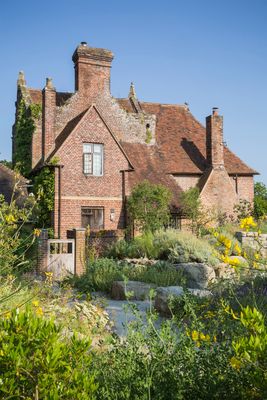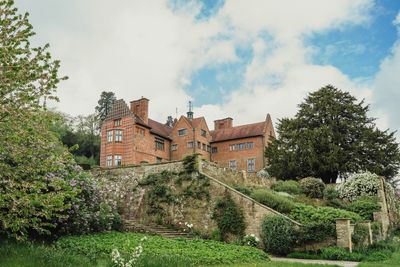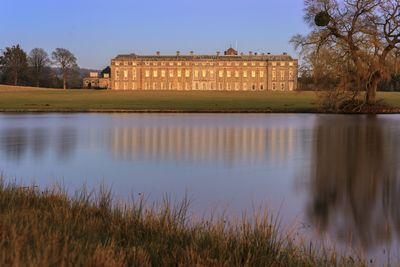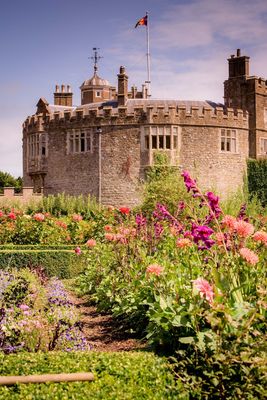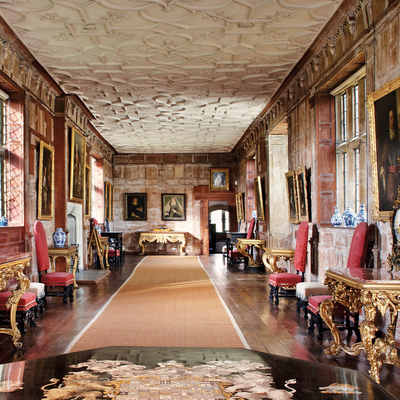
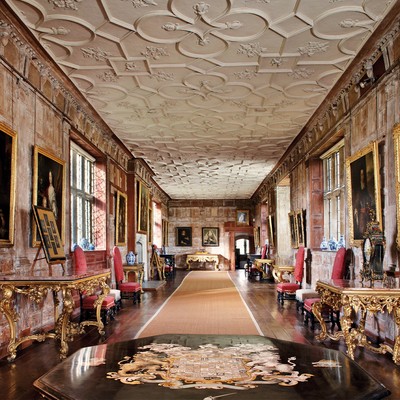
9 Stately Homes & Manor Houses To Visit In South East England
KNOLE
Where: Near Sevenoaks, Kent.
Why: Sitting proudly in Kent’s last medieval deer park, 600-year-old Knole was built as an archbishop’s palace in the mid 15th century. It became a royal possession during the Tudor dynasty when Henry VIII hunted in the grounds. From 1603, Thomas Sackville made it the aristocratic treasure house for his family, who were prominent in court circles and used it to display their wealth and status. Today, it’s a National Trust property, though the Sackville family still live here. “It’s vast and glorious,” Blue Badge tourist guide Viv Haxby tells us. “The story goes that it’s a ‘Calendar House’, boasting 365 rooms, 52 staircases, 12 entrances and 7 courtyards, but I’m not sure who’s counting!” she added. As you arrive, you’ll take in the scale and magnificence of the estate, then explore the grand courtyard and Orangery, and wander through the parkland. Inside, art lovers will find paintings by Reynolds, Gainsborough and Van Dyck, as well as 17th-century tapestries and furniture.
How: Click here for information.
PENSHURST PLACE
Where: Near Tonbridge, Kent.
Why: Penshurst Place dates to the 14th century when the Baron’s Hall was built as a country retreat for the Lord Mayor of London. Since 1552, it has been the ancestral home of the Sidney family – today, Philip Sidney, 2nd Viscount De L’Isle, and his family still live here. “This is a truly magnificent example of 14th-century architecture at its best,” comments Viv. In the opulent staterooms (which have featured in popular TV and film productions such as Wolf Hall) you’ll see family portraits from across the centuries, antique furniture and tapestries. “The gardens are fabulous, too!” says Viv. With 48 acres of grounds, including the 11-acre formal Grade I listed garden, they are among the oldest in private ownership, with records dating back to 1346. “I particularly love the 100-metre-long peony border that erupts into colour in late May,” she adds.
How: Click here for information.
SISSINGHURST
Where: Near Cranbrook, Kent.
Why: Sissinghurst Castle Garden has a diverse history, from serving as a prison in the 1700s to becoming a home for the women’s land army in the 20th century. In the 1930s, poet and writer Vita Sackville-West, and her diplomat and author husband Harold Nicolson, purchased Sissinghurst. “Of course, had Vita been born a boy, she would have inherited Knole,” Viv told us. “Instead, she and Harold made a family home and created one of our loveliest gardens here at Sissinghurst.” They were the last private owners and, after Vita’s death, Harold decided the property should be given over to the care of the National Trust. Today, you can take in the architecture of the extensive original buildings, the panoramic views from the top of the tower, the working farm and the 450-acre wider estate – along with Vita and Harold's famous gardens.
How: Click here for information.
CHARTWELL
Where: Near Westerham, Kent.
Why: Winston and Clementine Churchill bought Chartwell in 1922, and it was their family home for the next 40 years. Churchill loved Chartwell – he said ‘a day away from Chartwell was a day wasted’. Here, Churchill was a politician and statesman but also a husband, father, writer, painter and garden planner. The rooms in the house remain much as they were when he lived here, with pictures, books and personal mementoes. “It’s a very special place,” says Viv. “The highlight for me is the studio in the garden where Churchill painted and where, today, you can see many of his pictures.” The gardens reflect his love of landscape and nature, and include the lakes he created, the kitchen garden and the Marycot, a playhouse designed for his youngest daughter Mary. Beyond the gardens, there are trails and play areas in the woodland. The National Trust acquired Chartwell 18 years before Winston’s death, on the condition he and Clementine could live there for as long as they wished. In fact, Sir Winston reluctantly left Chartwell in October 1964 due to his poor health and moved to his London flat in Hyde Park Gate. He celebrated his 90th birthday on 30th November and died just a few weeks later, on 24th January 1965. Later that year, Lady Churchill decided she would live in London, and she too left Chartwell.
How: Click here for information.
PETWORTH HOUSE
Where: Petworth, West Sussex.
Why: Inspired by the Baroque palaces of Europe and set amidst a Capability Brown landscaped park and garden nestled in the South Downs, Petworth is an extraordinary place created by just one family over a 900-year period. The 17th-century building you see today “is imposing rather than beautiful,” says Viv. “The interior, however, is a joy and home to a world-class art collection.” The grand staterooms that were designed to display the taste, lifestyle and artistic patronage of generations of Percys, Seymours and Wyndhams display works by Van Dyck, Turner, Reynolds and Gainsborough, as well the earliest English globe in existence, dating back to 1592.
How: Click here for information.
IGHTHAM MOTE
Where: Near Sevenoaks, Kent.
Why: This picturesque 14th-century moated manor house is “magical, charming and delightful”, says Viv, “and surrounded by pretty, almost cottage-like gardens”. Built nearly 700 years ago, it has seen many changes and been owned by medieval knights, courtiers to Henry VIII and high-society Victorians. For the visitor, highlights include the courtyard, Great Hall, crypt, Tudor painted ceiling, Grade I listed dog kennel and the private apartments of the last owner, Charles Henry Robinson, who gave Ightham Mote to the National Trust in 1985. From the grounds, you’ll get views across the Kent countryside and remarkable displays of flora and fauna. If you’re visiting in spring, don’t miss the renowned ancient bluebell woodland at Scathes Wood.
How: Click here for information.
LEEDS CASTLE
Where: Broomfield, near Maidstone, Kent.
Why: One of the most visited historic buildings in Britain, Leeds Castle was originally a Norman stronghold. It is “perhaps the most photogenic of them all”, suggests Viv, “and once the private property of six of England’s medieval queens.” Later, it became a palace used by Henry VIII and his first wife Catherine of Aragon; a Jacobean country house; a Georgian mansion; and an elegant early 20th-century retreat for the influential and famous. The last private owner, Lady Baillie, was a wealthy Anglo-American heiress who acquired Leeds Castle in 1926 and was known for hosting glittering house parties here in the 1930s. The exhibition in the ancient Gatehouse will take you on a journey through over 900 years of history. Visitors come from far to view the castle itself, set in over 500 acres of landscaped parkland including a maze, a grotto, waterfowl, aviaries and a vineyard. Stay overnight to enjoy a walk round the grounds and gardens when the estate is closed to the general public. There is B&B accommodation or there is stylish glamping – if you want to experience a bit of the life of a medieval knight under canvas. For longer stays, there are five cottages that sleep between two and ten.
How: Click here for information.
WALMER CASTLE
Where: Walmer, near Deal, Kent.
Why: Standing guard over the Kentish coast since Tudor times, Walmer Castle is an artillery fort constructed by Henry VIII between 1539 and 1540 to protect against invasion from France. Originally part of a 2.7-mile coastal barrier that included Deal and Sandown castles, it developed into an elegant seaside retreat for politicians, aristocrats and royalty over the years – according to Viv, it was “intricately linked to military planning throughout the Napoleonic Wars and World War I”. And, “Appropriately, perhaps, it was here that our greatest military hero – the Duke of Wellington – died.” Today, it is the residence of the Lord Warden of the Cinque Ports, and visitors come to enjoy the eight acres of gardens and woodland as well as the interiors. Collection highlights include a pair of Wellington’s boots, designed and worn by the Duke himself, and a death mask made three days after he passed away.
How: Click here for information.
ARUNDEL CASTLE
Where: Arundel, West Sussex.
Why: There are nearly 1,000 years of history at this great restored and remodelled medieval castle, situated in magnificent grounds overlooking the river Arun. It was established during the reign of Edward the Confessor and completed at the end of the 11th century by Roger de Montgomery, Earl of Arundel. Apart from the occasional reversion to the Crown, Arundel has descended directly from 1138 to the present day, and has been the seat of the Dukes of Norfolk for over 850 years. “As you would expect of the house of our premier duke, this one is sumptuous and oozes art treasures and history in equal measure,” Viv comments. Visitors can take in the staterooms with their fine art, fabulous furniture and intricately carved statues; the individually decorated bedrooms with Victorian and Edwardian bathrooms; the Fitzalan Chapel; the inner gatehouse with its medieval defences, towers, portcullis and drawbridge; and the keep which was designed in the 11th century to prevent attack and control the river. In the gardens, you will come across a wonderful variety of landscapes, from the quirky Stumpery to the formal Collector Earl’s garden.
How: Click here for information.
Viv Haxby is a Blue Badge tourist guide, a driver guide and a member of the Institute of Tourist Guiding.
DISCLAIMER: We endeavour to always credit the correct original source of every image we use. If you think a credit may be incorrect, please contact us at info@sheerluxe.com.
